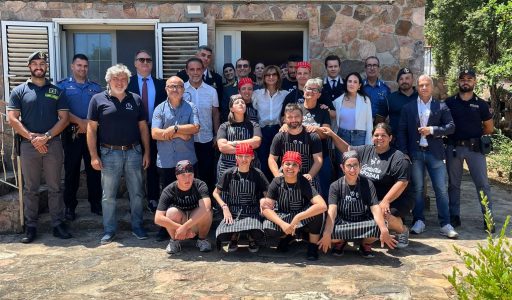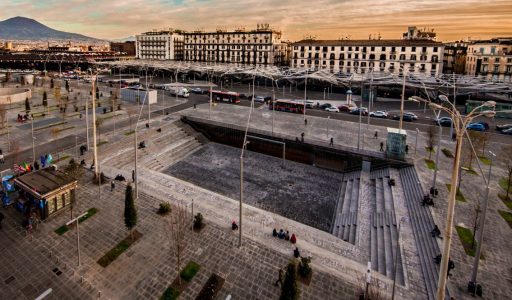Jobs for refugees in Godfather country
2 March 2016

Lorenzo Tondo wrote an article on the British newspaper The Guardian about “D.r.a.g.o.”, a project which is giving work and hope in Sicily for people coming from wor-torn countries. The project is promoted by the Association Laboratorio della Legalità and it is supported by Fondazione CON IL SUD.
Badu does not know who the bloodthirsty Totò “The Beast” Riina is and he has never even heard of Bernardo “The Tractor’’ Provenzano. Yet the green countryside where this 24-year-old Gambian refugee works once belonged to Cosa Nostra, the fearsome Sicilian mafia, of which Riina and Provenzano were the undisputed leaders. Of course he has seen The Godfather. “At least four times,” he says. Badu also knows this is the town where Marlon Brando’s famous Don Vito was born and raised.
Welcome to Corleone, in the dark heart of Sicily, between fragrant vineyards, wheat fields and expanses of olive trees, which the real-life mafia has commanded for more than 30 years, transforming it into its stronghold. Today – in a region notorious worldwide for its bosses and murder victims – refugees Badu, Aziz, Seydou and Mohammed work in fields confiscated from the mafia.
The project is called Drago – development resources agricultural growth organic – and provides training for asylum seekers on farmland seized by the police and handed to co-ops, which use them to produce organic oil, pasta, wine and vegetables. The refugees participate in the cultivation of the products, from the processing to the packaging, which are then stamped with a special “Protection- money free” label. This mark certifies the legality of the product in a land where the mafia has long subjugated small entrepreneurs and traders, forcing them to give the bosses a part of their profits.
“This project,” says Andrea Camellini, project manager of Girasoli – the association that handles the hospitality of thousands of refugees in Sicily – “aims to be an example of how to reuse confiscated mafia assets, promoting social and sustainable development. It is a serious and ethical way to contribute to the economic growth of the territory.”
There are 11 refugees working in Corleone, selected from the numerous relief camps in Sicily. In addition to clothing, food and accomodation, asylum seekers receive a salary of about €600 a month from the EU through the fund for refugees. The majority have never worked in the fields before. Zafir, 38, who comes from war-torn Kashmir, is a mathematics teacher. Seydou, 24, who fled from Gambia, is a tailor. Salif, 31, from Mali, worked as an electrician.
“It was not easy teaching them crop techniques,” continues Camellini, “but we got there in the end and many of them would like to continue working in this sector. Over the course of a year, more and more of them have arrived. They eat and sleep in our office and, in the morning, we take them to the fields.”
The alarm sounds promptly at 6am. Just enough time for a quick breakfast of croissants and coffee. Around 7am, Badu and his friends climb aboard a rickety blue van that takes them to the Cosa Nostra vineyards about 2km from the town, over a winding and bumpy road, through fields, farms and sheep pastures. There are about 50 hectares of land and, until 2007, it belonged to Giovanni Grizzaffi, 63, faithful nephew of Riina, who was arrested in 1993 and is considered the most vicious mobster in the history of the mafia, responsible for the deaths of more than 60 people. Grizzaffi was commissioned to manage and administer Riina’s assets, including the lush vineyards that, this morning, the refugees are busy pruning.
“At first, it was strange to work here,” says Badu, who arrived in Sicily from Gambia via Libya on a boat in 2014. “When we were told these lands belonged to the mafia, I cannot deny I was afraid. I knew the Sicilian mafia only from films and I was afraid that, one day or another, we would be killed for what we were doing. It took me a while to get used to it and stop looking over my shoulder every time I heard a strange noise.”
It will be another two years before Grizzaffi sets foot in Corleone again. The police arrested him in 1993, a few weeks after Riina’s capture, and sent him to a maximum security prison to serve a 25-year sentence.
Despite the fact that the Corleone bosses are almost all behind bars, the town remains under the strict supervision of the police. In recent weeks, the local administration has been investigated for mafia links.
“The mafia in Corleone is not dead,” explains Calogero Parisi, president of the co-op Lavoro e Non Solo – which, since the end of the 90s, has been in charge of the management of the confiscated lands. “It has simply been suppressed by arrests and convictions. After one boss is caught, another immediately takes over. The new boss will have already nominated his replacement, should he too be killed or arrested.”
The mafia of Corleone certainly do not like the idea that their land now belongs to the community and organisations that preach the culture of legality. So, from time to time, the bosses send their families to invade the land that once belonged to them, grazing their sheep on the fields now cultivated by the refugees. It is a way to make clear that, sooner or later, they will take it back. “We’ve reported them many times,” says Parisi. “They are trying to intimidate us, but we are not afraid. These lands have always belonged to wealthy landowners who, throughout history, used the mafia to subjugate and exploit the people. Now it’s time to return them to the community.”
Parisi sees the project of reusing assets confiscated from the mafia as a continuation of peasant struggles against wealthy landowners. For it was in these fields around Corleone that the struggle for the reconquest of the land began, in postwar Italy. Back then, farmers and peasants occupied the uncultivated lands of rich landowners who refused to concede them, despite a law obliging them to do so. To prevent the farmers from occupying them, the landowners struck a deal with the bosses of Cosa Nostra who, armed with rifles, guarded their fields. A union leader, Placido Rizzotto, decided to champion the peasants’ cause. In 1948, Rizzotto was kidnapped, killed and dismembered on the orders of the then-boss, Luciano Leggio. The remains of his body were found in 2009, in a cave near the village. Today, Badu proudly shows off a bottle of red wine bearing Rizzotto’s name. It is a fragrant wine pressed from the organic grapes that Badu and his companions have collected in the lands confiscated from the mafia.
But why choose to employ refugees? “Because history is repeating itself in Corleone,” says Parisi. “Back then, it was the peasants – the poorest social class, marginalised and dispossessed in Europe – who took back the land. Today, it’s up to the refugees. They are the new poor and marginalised and we have decided to stand beside and defend them.
From mafia city to a haven for refugees: Palermo moves on from its criminal past
“See, it is not enough to welcome migrants by giving them food and a roof,” he says. “You also need to integrate them and one of the first steps of integration is through work.”
In the late afternoon, as the sun is setting, Badu, Zafir and the other refugees return from the countryside to their lodgings. Before dinner, Zafir takes me outside for a chat and a smoke. He is tired. In recent days, the rain has turned the ground into a muddy swamp. “In the evening, we go home exhausted but satisfied,” says Zafir, who dreams of one day owning land in Sicily and living on it with his wife, who remains in Kashmir. Pointing towards a huge three-storey building, he adds: “Do you see that house? It used to belong to Totò Riina. The Italians arrested him, and now they’ve turned it into a police station. Also, our rooms, here in the cooperative’s headquarters, were the same rooms where the bosses ate and slept.
“We also have mafia in Kashmir. The mujahideen are like mobsters. When I look at what the Italians have done here, I realise how far away my land is.”


